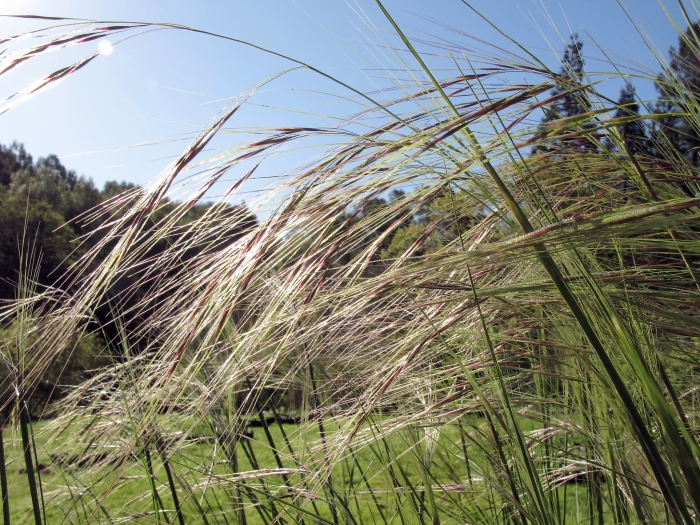Nodding Needlegrass
(Nassella cernua)
Nodding Needlegrass (Nassella cernua)
/
/

John Rusk
CC BY 2.0
Image By:
John Rusk
Recorded By:
Copyright:
CC BY 2.0
Copyright Notice:
Photo by: John Rusk | License Type: CC BY 2.0 | License URL: https://creativecommons.org/licenses/by/2.0/ | Uploader: John Rusk | Publisher: Flickr |










Estimated Native Range
Summary
Nassella cernua, commonly known as Nodding Needlegrass, is a deciduous perennial grass native to the chaparral, grasslands, and oak woodlands of California and Northwestern Mexico. It typically grows 2–3 feet (0.61–0.91 m) tall, with narrow, waxy-textured leaves. The plant is characterized by its nodding inflorescences, which are particularly noticeable when the grass is in bloom. Flowering occurs in late spring to early summer, and the flowers are not particularly showy, but they add a fine texture to the landscape.
Nodding Needlegrass is valued for its adaptability to dry conditions, making it an excellent choice for xeriscaping. It is used in native plant gardens, wildlife habitats, and for erosion control due to its bunching habit. This grass is also appreciated for its low water requirements, thriving in full sun to part shade and preferring soils with medium to slow drainage. While it is drought-tolerant, occasional deep watering during extended dry periods can help maintain its vigor. Nodding Needlegrass is not known for having significant disease problems or aggressive roots, making it a low-maintenance option for gardeners. However, it can self-seed and spread if conditions are favorable, so management may be necessary to keep it contained.CC BY-SA 4.0
Nodding Needlegrass is valued for its adaptability to dry conditions, making it an excellent choice for xeriscaping. It is used in native plant gardens, wildlife habitats, and for erosion control due to its bunching habit. This grass is also appreciated for its low water requirements, thriving in full sun to part shade and preferring soils with medium to slow drainage. While it is drought-tolerant, occasional deep watering during extended dry periods can help maintain its vigor. Nodding Needlegrass is not known for having significant disease problems or aggressive roots, making it a low-maintenance option for gardeners. However, it can self-seed and spread if conditions are favorable, so management may be necessary to keep it contained.CC BY-SA 4.0
Plant Description
- Plant Type: Grass
- Height: 2-3 feet
- Width: 1-2 feet
- Growth Rate: Rapid
- Flower Color: N/A
- Flowering Season: Spring
- Leaf Retention: Deciduous
Growth Requirements
- Sun: Full Sun, Part Shade
- Water: Low
- Drainage: Medium, Slow
Common Uses
Butterfly Garden, Deer Resistant, Drought Tolerant, Erosion Control, Low Maintenance, Rock Garden
Natural Habitat
Native to chaparral, grasslands, and oak woodlands
Other Names
Common Names: Foothill Needlegrass, Nodding Tussockgrass
Scientific Names: , Nassella cernua, Stipa cernua, Stipa pulchra var. cernua,
GBIF Accepted Name: Nassella cernua (Stebbins & Love) Barkworth